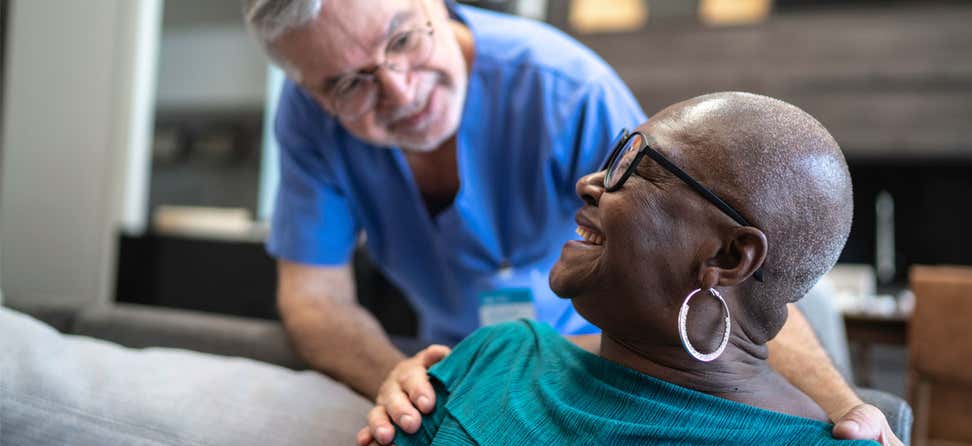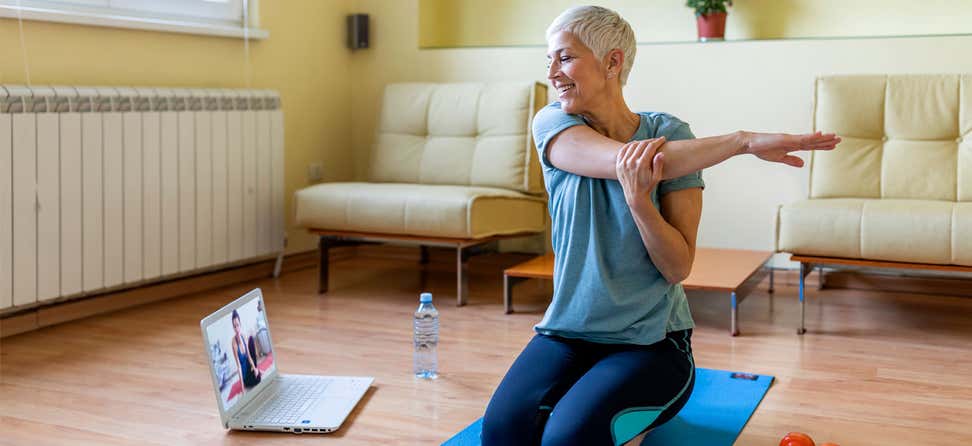Key Takeaways
Older and middle-aged adults in the United States account for about 80% of those who experience chronic pain.
Chronic pain is discomfort that persists for three months or more and can be caused by many different factors, most notably chronic conditions.
The purpose of this issue brief is to educate community-based providers about the common and growing problem of chronic pain in older adults.
Older and middle-aged adults in the United States account for about 80% of those who experience chronic pain.1 Since the most common treatment for chronic pain is analgesics or pain relievers, older adults have been increasingly prescribed medications, including opioids, to manage this condition.
According to the U.S. Department of Health and Human Services, in 2016:
- One in three Medicare Part D prescription drug beneficiaries received an opioid prescription;
- 500,000 beneficiaries received high amounts of opioids; and
- Almost 90,000 Medicare beneficiaries were at serious risk of addiction due to being prescribed high amounts of opioids.2
Appropriately managing chronic pain experienced by older adults is an important goal for health care providers and anyone working with older adults in community-based settings. Balancing the need for effective pain management while preventing medication misuse, abuse, and addiction must be an integral component of achieving this goal.
The purpose of this issue brief is to educate community-based providers about the common and growing problem of chronic pain in older adults, provide background on how evidence-based programs can be an important tool for pain management, and offer insights into successful strategies for implementation of the Chronic Pain Self-Management Program.
Background on Chronic Pain in Older Adults
Chronic pain is discomfort that persists for three months or more and can be caused by many different factors, most notably chronic conditions. Pain can negatively impact physical, mental, sexual, and cardiovascular health, including a person’s ability to complete daily activities, think clearly, sleep, and manage their mood. It can also lead to increased physician visits, medication use, challenges with going to work, and hospital stays.1
As we age, ongoing health conditions are more prevalent, with 80% of older adults diagnosed with at least one chronic condition and 68% diagnosed with 2 or more.3 Common chronic conditions that frequently cause pain include arthritis, diabetes, cancer and cancer treatments, and the end stages of heart failure, chronic kidney disease, and chronic obstructive pulmonary disease. Pain may also be caused by neuropathic conditions such as fibromyalgia, surgeries, and joint repair or replacements.4 Injuries like sprains, muscle damage, and fractures may contribute to pain—including hip and vertebral fractures prevalent in older adults.
Not only are older adults more likely to experience ongoing pain, but they also have unique characteristics that make it more difficult to manage. In general, they use more prescription and over-the-counter medications than other age groups,5 which can lead to misuse and abuse—often unintentional. Older adults are also more likely to experience medication-related side effects6 and small amounts of medications may result in problems due to increased sensitivity and slower metabolism and eliminations.5
Thirty percent of Medicare Part D beneficiaries were prescribed opioids in 2016, showing that they are not exempt from the high level of opioids prescribed in the United States overall. Opioids are painkillers that include several different types of medications including codeine, morphine, oxycodone (Percocet®, OxyContin®), hydrocodone (Vicodin®), meperidine (Demerol®), methadone, and fentanyl—the most potent opioid available by prescription. Misuse or abuse of prescription opioids can be particularly problematic for older adults due to serious side effects, including respiratory depression, dizziness, and confusion.7 Due to these side effects, older adults who take these medications increase their risk of falling to four to five times more than those who take nonsteroidal anti-inflammatory drugs (for example, aspirin, Motrin® or Advil®).8 Moreover, the rate of adults aged 60+ taking prescription opioids with suicidal intent has increased, contributing to a 640% rise in opioid-related deaths between 2000 and 2015 for individuals aged 55-74.9 Ultimately, dependence on prescription pain medication can lead to illegal heroin use, with nearly 80% of Americans using heroin reporting misuse of prescription medications first.10
Medications should be a part of a treatment plan that also includes alternative methods to encourage older adults to take an active role in their pain management. These alternatives may include self-management programs, cognitive behavioral therapy, physical therapy, guided imagery, pain support groups, physical activity programs, acupuncture, hypnosis, and others. These methods may also help those who are misusing, mismanaging, or abusing opioids or other medications. The value of alternative therapies was reinforced by a recent study of tai chi showing it may be a useful treatment for fibromyalgia with improvements in physical and mental components that were maintained at 24 weeks.11
The Role of the Chronic Pain Self-Management Program
Both the Chronic Pain Self-Management Program (CPSMP) and evidence-based physical activity programs, including those focused on falls prevention, can be important tools for pain management. CPSMP was originally developed at Stanford University’s Patient Education Research Center as part of the suite of Chronic Disease Self-Management Education programs, now operated by the Self-Management Resource Center. CPSMP, offered widely across the U.S., is a highly participatory small group workshop for people with chronic pain that consists of 2 ½ hour weekly sessions conducted over six weeks. Participants learn techniques to manage frustration, fatigue, isolation, and poor sleep, as well as strategies to engage in appropriate exercise and medication management. The curriculum also focuses on ways to communicate effectively with family, friends, and health professionals; adopt healthy nutrition habits; and evaluate new treatments. Participants learn skills to problem solve, make decisions about key aspects of their chronic pain, and create action plans.
In response to the growing need for resources focused on medication management and appropriate use of opioids, the companion book for CPSMP, Living a Healthy Life with Chronic Pain, now includes an appendix on opioid use, which is also available online. Furthermore, organizations offering CPSMP should be cognizant of the potential challenges of offering the programs to groups with participants that are managing opioid addiction. Training in substance use disorders may be needed by leaders to effectively deliver the program.
Further research is being conducted by the Patient-Centered Outcomes Research Institute (PCORI) to assess the effectiveness of CPSMP as one of two methods for behavioral pain management in patients prescribed long-term opioids. Patients as part of an opioid tapering program will be assigned to cognitive behavioral therapy to address chronic pain, the CPSMP, or a control group which will not receive a behavioral intervention to test which of these two types of pain management interventions is more effective for reducing pain and pain interference, increasing function, and reducing opioid use within the context of active, collaborative, patient-centered opioid reduction.12
The Role of Evidence-Based Physical Activity & Falls Prevention Programs
Prospective results from recent epidemiological studies indicate that a physically active lifestyle may reduce the risk of developing chronic pain.13 Regular, moderate-intensity, physical activity may have a protective effect for lower back pain and musculoskeletal pain in older adults.14 However, fear of falling may cause older adults to limit their activities. Evidence-based falls prevention and physical activity programs can help individuals in the community increase their activity level by strengthening muscles, learning balance exercises,15 and reducing their fear of falling.
A meta-analysis of more than 1,330 articles on falls in older adults in 2013 found that, “community-dwelling older adults with pain were more likely to have fallen in the past 12 months and to fall again in the future. Foot and chronic pain were particularly strong risk factors for falls.”16
Implementation and expansion of evidence-based Chronic Disease Self-Management Education (CDSME), physical activity, and falls prevention programs have been supported by the Administration for Community Living (ACL) since 2003 and grantees have successfully offered programs in partnership with community-based organizations, health care entities, treatment facilities, law enforcement, substance abuse organizations, and others. ACL supports the National CDSME and Falls Prevention Resource Centers, housed at NCOA. To learn more about evidence-based programs in your state, consider connecting with an ACL CDSME grantee or falls prevention grantee.
Successful Practices from the Field
Partners in Care Foundation
Partners in Care Foundation in California received a grant from ACL in 2017 to expand capacity to implement CPSMP. Workshops are being coordinated by counties across the state as well as in partnership with Blue Shield, who will implement a pilot to offer CPSMP to members experiencing certain conditions. In addition, several counties in the state are experimenting with cross-referrals between CPSMP and related evidence-based programs. For example, one county is pairing CPSMP with the Arthritis Foundation Exercise Program (AFEP). This allows individuals with arthritis to participate in CPSMP before, during, or after AFEP. Other organizations are coordinating CPSMP and Tai Chi for Arthritis or Tai Ji Quan: Moving for Better Balance.
Overall, work is underway to build coalitions focused on creative ways to manage pain outside of opioid use. This includes engaging non-traditional partners, like chiropractors and Emergency Medical Services (EMS), with the intent of increasing the recognition of chronic pain and linking people to CPSMP.
Currently, EMS providers who respond to reports of falls provide initial information about the falls prevention program, A Matter of Balance. They also follow up a couple of weeks following the fall with a pamphlet about falls prevention programs and CPSMP.
The Living Well Center of Excellence at Maintaining Active Citizens
The Living Well Center of Excellence at Maintaining Active Citizens – MAC, Inc., an area agency on aging in Maryland, has implemented CPSMP in partnership with pain centers, older adult communities, and an education and training center that serves homeless Veterans in Baltimore. Other potential partners include the state Quality Improvement Organization/Quality Innovation Network (QIO/QIN), local health departments, and the sheriff’s office.
Michigan Department of Health and Human Services Aging and Adult Services
The Michigan Department of Health and Human Services Aging and Adult Services holds CPSMP in senior centers, churches, hospitals, independent living centers, and housing complexes. Participants are encouraged to bring pillows or adaptive devices and to do whatever is needed to be comfortable during the sessions, including sitting, standing, and lying on the floor. CPSMP is the second most sought out program in Michigan (A Matter of Balance is first), with a waiting list to join the program in some areas of the state. The most successful methods to engage participants have been word of mouth or recruitment at senior centers. In addition, some of the area agencies on aging are working with large health systems to educate doctors about the program and its potential value for individuals who are opioid dependent. In the future, they also hope to educate medical students.
“More than other programs, the leaders have chronic pain themselves or family members with chronic pain so they are more able to relate to those in the class.”
—Sherri King, Michigan Office of Services to the Aging
The University of North Carolina at Asheville’s NC Center for Health and Wellness
The University of North Carolina at Asheville’s NC Center for Health and Wellness established an evidence-based program training academy in collaboration with an area agency on aging to increase capacity to implement programs across the state, including CPSMP. The center developed the HealthyAgingNC website to promote CPSMP workshops and training opportunities, which has been an effective way of raising awareness about CPSMP and other chronic disease self-management education programs. They also have created a fact sheet about opioid use and how to find a CPSMP workshop.
"I greatly admire the design of the CPSMP. It allowed people to open up about their inability to deal with pain in socially acceptable and legal ways and to begin trying new techniques. It took more interpersonal skills to work with clients with addiction because they often have several challenges—unable to maintain a job, dependent on resources for low income individuals, dealing with family problems, etc."
—CPSMP Leader in North Carolina
Ohio Department of Aging
The Ohio Department of Aging has offered CPSMP in Cleveland and Dayton regions for several years and has recently expanded statewide, after research indicated interest in other parts of the state. The main partners in implementation and expansion have been health centers, senior centers, and the Veterans Administration in Columbus. Programs have largely been supported through Older Americans Act Title III-D funding, but some area agencies on aging have utilized additional funding sources.
“CPSMP workshops have been going well in Cleveland and Dayton regions because a majority of older adults experience chronic pain and can identify with CPSMP. The Ohio Department of Aging is pleased to offer the program in many Ohio counties through local area agencies on aging to better serve our constituents.”
—Berrie Mabins, Ohio Department of Aging
Utah Department of Health
The Utah Department of Health is collaborating with several partners to offer CPSMP. Intermountain Healthcare, the largest health care delivery partner in Utah, became interested in CPSMP following a community health needs assessment which identified chronic pain as one of five priority areas for care. In response to this need, CDSMP is being implemented to address hypertension and chronic pain, as well as opioid misuse and addiction at their pain clinic. It is the only community-based program where physicians can refer patients for increased support to manage chronic pain. In addition,12 University of Utah community clinics and the Five County Association of Governments plan to embed CPSMP into their routine operations and Utah State University’s Center for Persons with Disabilities and the Violence and Injury Prevention Program also plan to partner to expand use of the program.
Area Agencies on Aging in Virginia
Two area agencies on aging (AAA) in Virginia are offering CPSMP. The program was initiated by an AAA in Southwest Virginia in response to local physicians concerned about patients coping with chronic pain who would be affected by new regulations limiting the amount of opioid prescriptions that can be filled between office visits. In order to support patients with chronic pain, workshops have been held at senior centers, community centers, a federally-qualified health center, a retirement community, and correctional facilities.
This effort will be expanded as a health system in Virginia has been awarded a federal grant from the U.S. Department of Health and Human Services Office on Women’s Health to help prevent opioid misuse in their service region, particularly among women. They will partner with an AAA and local department of health to help combat opioid misuse among women aged 35+ by lowering the number of inappropriate prescriptions, providing support and education for both women and health care providers, and removing unneeded opioid medications from the community through drug take-back programs.
Resources for Professionals
- CDC Guideline for Prescribing Opioids for Chronic Pain
- CDC Webinar Series: Guidelines for Prescribing Opioids for Chronic Pain
- American Geriatrics Society, Pharmacologic Treatment of Pain in Older Adults
- CDC Opioid Overdose Prevention Microsite
- Heartache, Pain, and Hope: Rural Communities, Older People, and the Opioid Crisis
- Office of the Surgeon General’s Turn the Tide Initiative
- Opioid Use in the Older Adult Population
- Prescription Medication Misuse and Abuse Among Older Adults
- Office of the Inspector General: Opioids in Medicare Part D: Concerns about Extreme Use and Questionable Prescribing
Resources for Older Adults and Caregivers
- CDC Webinar: Nonopioid Treatments for Chronic Pain
- The Opioid Epidemic: By the Numbers
- Prescription Opioids: What You Need to Know
- Pain: You Can Get Help
- Role of Physical Activity in Managing Chronic Pain in Older Adults
Sources
1. Robinson, Kayin T., Bergeron, Caroline D., Mingo, Chivon A., Meng, Lu, Ahn, SangNam, Towne Jr., Samuel D., Ory, Marcia G., and Smith, Matthew L. “Factors Associated with Pain Frequency Among Adults with Chronic Conditions,” Journal of Pain and Symptom Management, 54 (2017): Issue 5, 619–627.
2. U.S. Department of Health & Human Services Office of Inspector General. “Opioids in Medicare Part D: Concerns about Extreme Use and Questionable Prescribing.” Accessed March 7, 2018. Found on the internet at https://oig.hhs.gov/oei/reports/oei-02-17-00250.pdf
3. NCOA. “Top 10 Chronic Conditions in Adults 65+ and What You Can do to Prevent or Manage Them.” Accessed March 9, 2018. Found on the internet at https://www.ncoa.org/article/the-top-10-most-common-chronic-conditions-in-older-adults.
4. Reid, M.C., Eccleston, C., Pillemer, K. “Management of Chronic Pain in Older Adults,” The BMJ, 350(2015), 532.
5. Administration on Aging and Substance Abuse and Mental Health Services Administration. “Older Americans Behavioral Health Issue Brief 5: Prescription Medication Misuse and Abuse Among Older Adults.” Accessed March 9, 2018. https://www.ncoa.org/article/prescription-medication-misuse-and-abuse-among-older-adults.
6. Ferrell, B., Argoff, C.E., Epplin, J., Fine, P., Gloth, F.M., Herr, K., Katz, J.D., Mehr, D.R., Reid, C., Reisner, L. “Pharmacological Management of Persistent Pain in Older Persons,” American Geriatrics Society Panel on the Pharmacological Management of Persistent Pain in Older Persons, 57 (2009): 1331 – 1346.
7. Chau, D.L., Walker, V., Pai, L., Cho, L.M. “Opiates and Elderly: Use and Side Effects,” Clinical Interventions in Aging, 3(2008): Issue 2, 276.
8. Krebs, E., Paudel, M., Taylor, B.C., Bauer, D.C., Fink, H.A., Lane, N.E., and Ensrud, K.E. “Association of Opioids with Falls, Fractures, and Physical Performance among Older Men with Persistent Musculoskeletal Pain,” Journal of General Internal Medicine. 31 (2015): Issue 5, 463-469.
9. Trust for America’s Health. “Pain in the Nation: The Drug, Alcohol and Suicide Epidemics and the Need for a National Resilience Strategy.” Accessed March 9, 2018. Found on the internet at http://healthyamericans.org/assets/files/TFAH-2017-PainNationRpt-FINAL.pdf.
10. National Institute on Drug Abuse. “Heroin.” Accessed March 9, 2018. Found on the internet at https://www.drugabuse.gov/publications/drugfacts/heroin
11. Weng, C., Schmid, C., Rones, R., Kalish, R., Yinh, J., Goldenberg, D., Lee, Y., and McAlindon, T. “A Randomized Trial of Tai Chi for Fibromyalgia,” New England Journal of Medicine, 363 (2010): Issue 8: 743 –754.
12. Patient-Centered Outcomes Research Institute. “Comparative Effectiveness of Pain Cognitive Behavioral Therapy and Chronic Pain Self-Management within the Context of Opioid Reduction.” Accessed March 9, 2018. Found on the internet at https://www.pcori.org/research-results/2017/comparative-effectiveness-pain-cognitive-behavioral-therapy-and-chronic-pain
13. Bruce, B., Fries, J.F., Lubeck, D.P. “Aerobic Exercise and Its Impact on Musculoskeletal Pain in Older Adults: A 14-year Prospective, Longitudinal Study,” Arthritis Research & Therapy. 7(2005): Issue 6, 1263-1270.
14. Naugle, K.M. “Role of Physical Activity in Managing Chronic Pain in Older Adults.” Accessed March 7, 2018. Found on the internet at https://www.practicalpainmanagement.com/treatments/rehabilitation/exercise/role-physical-activity-managing-chronic-pain-older-adults
15. NCOA. “Evidence-Based Falls Prevention Programs: Saving Lives, Saving Money.” Accessed March 9, 2018. https://www.ncoa.org/article/falls-prevention-programs-saving-lives-saving-money-infographic
16. Stubbs, B., Binnekade, T., Eggermont, L., Sepehry, A.A., Patchay, S., Schofield, P. “Pain and The Risk for Falls in Community-Dwelling Older Adults: Systematic Review and Meta-Analysis,” Archives of Physical Medicine and Rehabilitation. 95 (2014): Issue 1, 175-187.









